![]()
![]()
![]()
Use LEFT and RIGHT arrow keys to navigate between flashcards;
Use UP and DOWN arrow keys to flip the card;
H to show hint;
A reads text to speech;
163 Cards in this Set
- Front
- Back
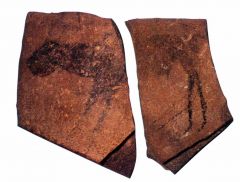
|
apollo 11 cave , Namibia, 23,000 BCE, Paleolithic-old stone, Africa, Charcoal, Ocher-iron ore, seen in profile
|
|

|
eurpeon painting found in Altimira, spain, 15,000-10,000, Bison images
multiple paintings at different times each Bison is about 5' long mixed with animal fat used bulge of rock to depict 3D Bison |
|
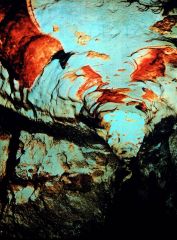
|
Axial Gallery
Lascaux france 15,00-13,000 BCE No humans No narrative and painted at different times composition profile-addition to profile |
|
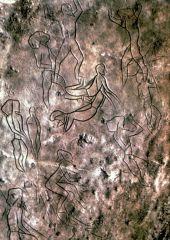
|
Ritual Dance?
Grotta Addaura Sicily ca. 10,000 BCE upper paleolithic 1rst humans all male |
|
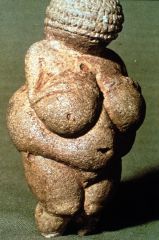
|
“Venus”
of Willendorf Austria 25,000-20,000 BCE totum of fertility no face concentration on the body limestone |
|
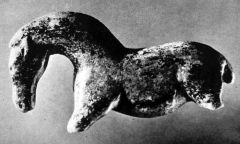
|
Horse, Vogelherd (Germany), ca. 28,000 BCE
amulet/jewlry made out of raindeer antler |
|
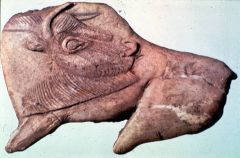
era?
|
Bison, La Madeleine (France), 15,000-10,000BCE
spear thrower-tool burin-shape pointed tool used to make detail paleolithic |
|
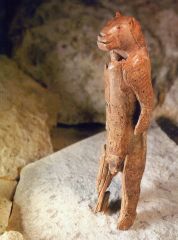
|
Hybrid figure
Hohlenstein-Stadel Germany 40,000-28,000 BCE Mammoth tusk 12" tall Human body feline face Shaminism-spirits, preists, or mediators transforming oneself |
|

|
Jericho
ca. 7000 BCE great stone tower built into the settlement wall, Jericho Jericho was protected by 5' walls and atleast one stone tower 33' high and 33' in diameter |
|

|
Plastered skull
Jericho ca. 7000 BCE buried the dead in the floors of their houses except the head seperate and displayed decorated with shells |
|
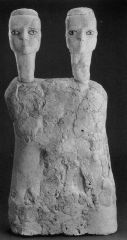
era?
what god? |
Human figures???
neolithic Ain Ghazal Jordan ca. 6750-6250 BCE The Enuma Elisha The chief god of the babylonians described as two heads a metaphor for infinite beauty (mardok) |
|
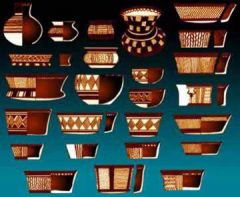
|
Hassuna pottery, Iraq, ca. 6000-5000
Fired paintings inspire by animal skins or baskets |
|
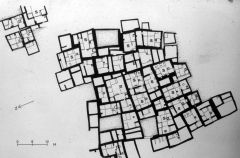
what era?
|
Çatal Hüyük, ca. 6000-5700
turkey neolithic no doors went in through roof kind of fortification divided up into activity spaces each had a platform |
|
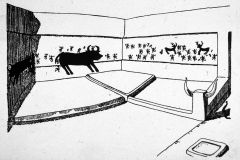
|
Shrine, Çatal Hüyük, ca. 6000-5700
decor for religious worship. Getting a story narrative 1rst time. Masculine spirit hunting |
|

|
“Goddess” relief, Çatal Hüyük
ca. 6000-5700 |
|

|
Volcano and town
Çatal Hüyük , ca. 6000 BCE earliest landscape painting Hasan Dag volcano.. |
|

where
|
Female figure
Cernavoda Romania ca. 3500 BCE fired clay came from a tomb thoughtful passive poses geometric/reduction |
|
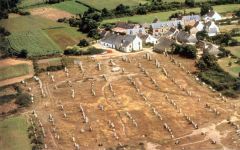
|
Menhir alignment
Menec (France), ca. 4250-3750 BCE Interest in building conlstruction of very large stone Megolithic-big stone vertical going from east to west 3-13' Menhir |
|
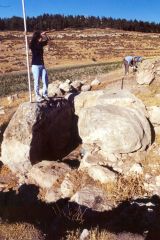
|
Dolmen
Tall al-`Umayri Jordan ca. 3000 BCE rooked structures=dolmen burial place of multiple plaster floor renovated 2 dozen burials |
|
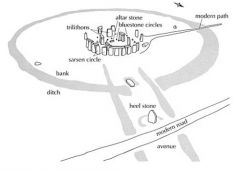
|
Stonehenge, Salisbury Plain, ca. 2100 BCE
built over centuries ditch around it faces east made of sarsen blue stones direction the sun rises during winter solstice |
|

|
White Temple, Uruk, ca. 3500-3000 BCE
temple controlled everthing home for a god represented by an image mud-bricks white wash large platforms bent axis approach cella-center room sumarian |
|
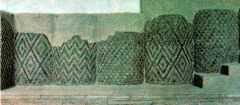
|
White Temple, Warka, ca. 3500-3000
only intended for certain people raises higher to get closer to the gods highley decorated w/ colored cones pushed into mud brick some flowers |
|
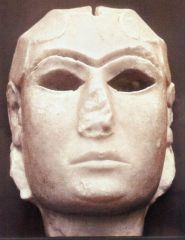
|
Inanna?
Uruk ca. 3200- 3000 BCE extremly expensive head Ishtar female rest of body would have been wooden maybe covered Acrolithic-exposed parts are wooden, rest less desirable material sumarian |
|
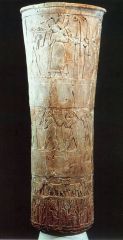
|
Warka Vase
Uruk sumarian ca. 3200-3000 BCE alabaster vase-carved from stone presentation of offering to inanna from Urak (modern Warka) Iraq blank space-register levels of importance |
|

|
Abu Temple statues, Tell Asmar, ca. 2700-2500 BCE
sumarian made of gypsome inlayed eyes called lapris lazuli(important material) |
|
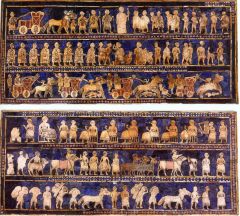
|
Royal Standard of Ur, ca. 2600 BCE
sumarian introduction of a king above temple rise of monarchy found by lenard wooly top panel-war bottom panel -peace hierachy of scaLE cenagers=chariots wooden panels, seashells, lapris lazeril, bitumen |
|

|
Goat in Thicket
Ur sumarian ca. 2600 BCE goat in thicket gold foil lapris lazerith cup holder to make an offering Tammur god |
|
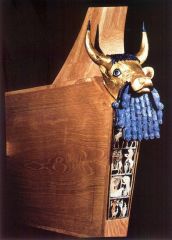
what style is it in?
|
Bull lyre
Ur sumarian ca. 2600 BCE found in cemetary harp of a sort head wraped in gold foil inlayed panel -mesopatamian mythology style-Heraldic compostion hybrid creatures sumarian |
|
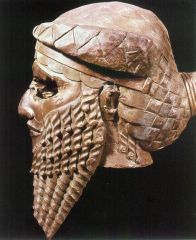
which ruler?
|
Akkadian ruler
Nineveh ca. 2250-2200 BCE bronze (naramsin)-probably dating to sargos grandson eyes were inlayed damaged on purpose around 600 BC probably stood 1600 years city was attacked by persians |
|

for who?
|
Ziggurat of King Urnammu, Ur, ca. 2100 BCE
Neo-sumarian period mudbrick inside-outside baked artificial mountain axix approuch Iraq one of the largest in mesopotamia |
|
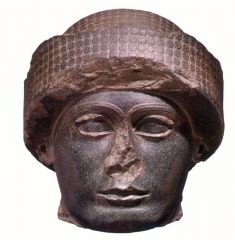
|
Head of Gudea
Lagash neo-sumarian ca. 2100 BCE carved in hard stone (diorite) |
|
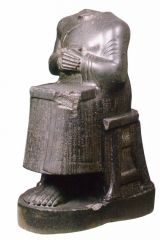
what era?
|
Seated Gudea
Girsu neo-sumarian ca. 2100 BCE hands clasped presenting plans for temple for Niniorsu 1rst known building plan |
|
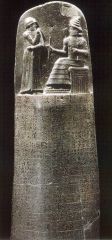
where was it found?
|
Stele with
Law Code of Hammurabi babylonian ca. 1760 BCE cration of legal code 8' babylon king and god (shalmash) 3,500 codes shows some educated society(literacy) 8 horned hat a coil rope and measuring rod-symbolic for building found in susa |
|
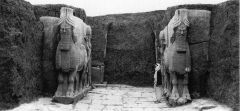
|
Lamassu
Citadel of Sargon II, Dur Sharrukin, 742-706 BCE entrance to plalace horned hats (dietys) assyrian |
|
|
|
Palace of Sargon II
Khorsabad (Dur Sharrukin) ca. 725 shaking holy water purifying |
|
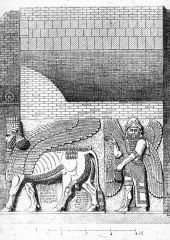
|
Palace of Sargon II
Khorsabad (Dur Sharrukin) ca. 725 purifying water |
|
|
|
Ziggurat
Palace of Sargon II Kh orsabad (Dur Sharrukin) ca. 725 bent axis painted dif colors |
|

|
Fugitives crossing the river
Palace of Ashurnasirpal II, Nimrud, BCE 883-859 assyrian ashur.....Succesor of Sargon specific battle (878BCE) enemys holding inflated animal skins bows go behind the head in order that it might me easier to understand 10' |
|
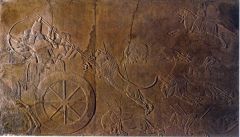
|
Lion Hunt
Palace of Ashurbanipal II, Nineveh, ca. 645 BCE hunt of vicous animals assyrian |
|
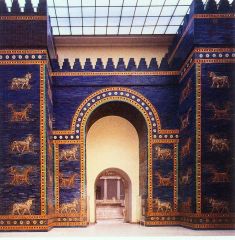
|
Ishtar Gate
Babylon neo-babylonian ca. 575 BCE babylon rises again the old testament babylon animals on gateway Mardok god (dragon) chief god adad ( bull) colored bricks raises from the surface first true arch crenellations (on top) look like ziggurat Iraq under king Nebuchadnezzar II |
|
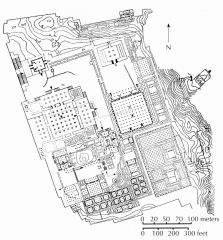
|
Palace of
Darius and Xerxes Persepolis 518-460 BCE persians were nomads up until the 6th century |
|
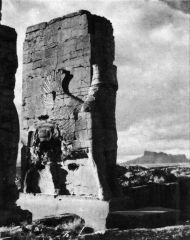
|
Gate of Xerxes
Persepolis ca. 450 lammasu they were interested in their pre-decestors |
|
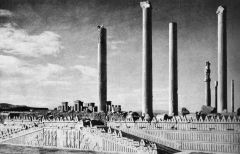
|
Audience Hall (apadana), Persepolis, ca. 500
|
|
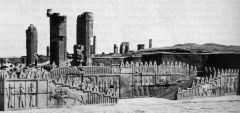
|
Tripylon, Persepolis, ca. 450
broad staircases taking past relief sculptures |
|
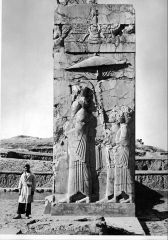
|
King
Apadana Persepolis ca. 500 entrance king is on the door always present abstacted connedtion between persia and greece sculpture may have been done by a greek bird is the persian god (ahura Masda) |
|

|
Darius and Xerxes, Persepolis, ca. 500
king reciaving guests his son behind him |
|
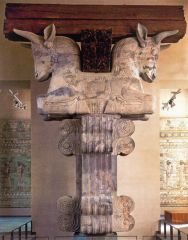
|
Bull capital
Persepolis ca. 500 BCE columns are decorated w/ animals 2 bulls + ornate scrolls ionic order columns volutes top is called the capital |
|
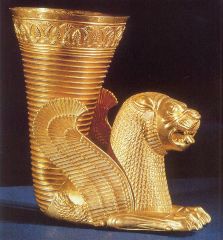
|
Rhyton
5th-3rd c. BCE solid gold drinking orn (rhyton) shape of bull horn luxiury item made w/ multiple pieces persian |
|
|
time of Sumarian art
|
3500-2332 BCE
|
|
|
sumarians founded the worlds first city states in the valley between______ and ______ and invented writing in the ___ millennium
|
tigris
euphrates fourth |
|
|
ziggurats were built by..
|
Sumarians
|
|
|
these were the first to place figures in registers to tell a coherent story
|
Sumarians
|
|
|
Time of Akkadian art
|
2332-2150 BCE
|
|
|
these were the first to call themselves kings and assume divine attributes.
|
Akkadians
|
|
|
The earliest recorded name of an author is..
|
The Akkadian priestess Enheduanna
|
|
|
Time of Neo-Sumarian and Babylonian art
|
2150-1600 BCE
|
|
|
during the ____ of Ur, the sumarians rose again to power and constructed one of the largest ziggurats in Mesopotamia at Ur.
|
3rd dynasty
|
|
|
Babylons greatest king, ________, established a comprehensive law code for the empire he ruled.
|
Hammurabi
|
|
|
who was the first to use forshortening??
|
Babylons
|
|
|
Time of Assyrian art
|
900-612 BCE
|
|
|
At the hiegth of thheir power, the Assyrians ruled an empire that extended?
|
from the Persian gulf to the Nile and Asia Minor
|
|
|
Lamassus are made by
|
The assyrians
|
|
|
Painted reliefs of lion hunt scenes are by the
|
Assyrians
|
|
|
Time of Neo-babylonian and Persian Art
|
612-330 BCE
|
|
|
In the ___ century the Babylonians constructed two of the seven wonders of the ancient world. Which two?
|
The Ishtar Gate and the ziggurat ( tower of babylon)
|
|
|
The capital of Achaemenid Persians was at Persepolis, where ____ and ____ ruled
|
Darius I and Xerxes
|
|
|
who conquerd the persian empire and when?
|
Alexander the Great in 330 BCE
|
|
|
list the Ancient near east art in order
|
Sumarian
Akkadian Neo-Sumarian Babylonian Assyrian neo-babylonian and persian |
|
|
paleolithic art
|
30,000-9000 BCE
|
|
|
Neolithic art
|
8000-2300 BCE
|
|
|
who grouped the pharoahs into catagorys?
|
Manetho-egyptian priest
|
|
|
what allowed to the understanding of the egyptian language??
|
The discovery of the rosetta stone
|
|
|
About when did upper and lower egypt unite? and under whos rule?
|
3000 BCE
Namer |
|
|
Hieroglyphics
|
writing system using pictures
|
|
|
Ben-Ben was symbolic of?
|
the sun and the creation of earth
|
|
|
Amon-Ra
|
Sun god
|
|
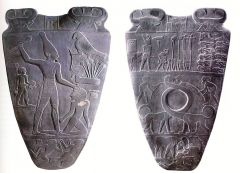
|
Palette of Narmer, from Hierakonopolis, 3150-3125 BCE
predynastic stone tablet made of slate commemorates unification of egypt Horus is represented by a falcon make-up Pallete |
|
|
mastaba means?
|
bench(egyptian)
|
|
|
what is th Ka?
|
The spirit (egyptian)
|
|
|
what is a Heb-Sed festival??
|
celebration for pharoahs Jubilee
|
|
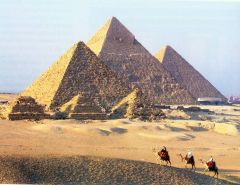
|
Pyramids of Menkaure, Khafra, and Khufu, Giza
built in the fourth dynasty Old kingdom related to creation story oreinted toward the rising sun Ben-Ben |
|
|
which pyramid is the oldest and largest?
|
the one Built for Khufu
|
|
|
how tall was the highest pyramid? how wide? how many stones?
|
450'-480' Tall
775 ft wide 2 1/2 million |
|
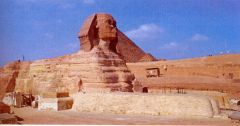
|
Great Sphinx, Giza, 2570-2544
infront of Kafra |
|
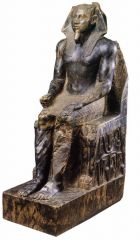
|
Khafra
Giza ca. 2500 BCE diorite linen headress is called-Nemes Horus is behind him depicted as youthful scarabe beetle in his hand (rebirth/sungod) fourth dynasty |
|
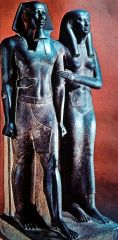
|
Menkaure and
Khamerenebty Giza ca. 2490-2472 Gesture implies marrage his weight is distributed no texture |
|
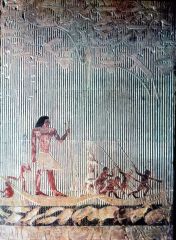
what dynasty?
|
Mastaba of Ti, Saqqara, ca. 2450
relief Ti was an overseer hunting hippo's composite prospective natural contest ( trees and animals above) 5th Dynasty old kingdom |
|
|
|
Ka-Aper
Saqqara ca. 2450 overseer made of wood inlayed eyes protruding belly(sign of wealth) |
|

|
Ka-Aper
Saqqara ca. 2450 overseer made of wood inlayed eyes protruding belly(sign of wealth) |
|
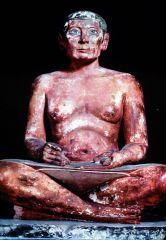
|
Seated scribe
Giza ca. 2450 limestone painted darker skin (male) belly=success in life fourth dynasty( old kingdom) |
|

|
Pepy II and
his mother ca. 2325 pharoah shows emotion and age New kingdom 12th dynasty red quarzite |
|

|
Tomb of Amennehmet, Beni Hasan
ca. 1950-1900 BCE 12th dynasty middle kingdom |
|
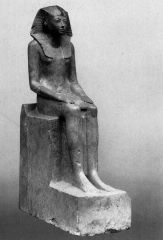
|
Hatshepsut
Deir el-Bahari 1475-1450 female pharoah married to Thutmose II (died young) new kingdom |
|
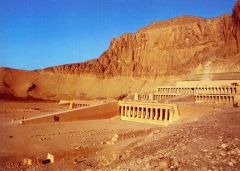
|
Temple of Hatshepsut, Deir el-Bahari, ca. 1478-1458 BCE
multi level rows of columns ascending street lined with sphynxes 18th dynasty new kingdom |
|
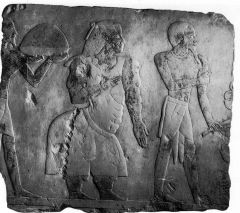
|
Temple of Hatshepsut, Deir el-Bahari, 1475-1450
shows a trip to punt to find trees for the temple (mrryh trees) obese wife |
|

where?
whos tomb? what dynasty? |
Musicians and dancers, Thebes ca. 1350 BCE
in a tomb of Nebamun banquet associated with funeral 18th dynasty fresco frontal veiws deviating from the typical egyptian art |
|
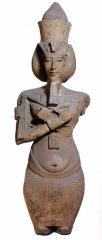
|
Akhenaten
Karnak, Thebes 1353-1335 BCE first name (Amenhotep IV) 18th dynasty sandstone first king to institute new religion (sun disk "aton") monotheism declared new capital ( amarna) art changed dramatically to stretched features and sagging bellly genderless |
|

|
Akhenaten and family, ca. 1355 BCE from amarna)
Nefertiti-wife 18th dynasty limestone 3 chidren rays of sunlight having hands(Aton) shows an intamacy never before seen in egyptian art |
|
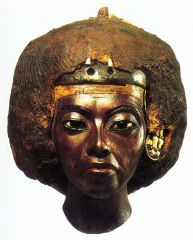
|
Queen Tiy
1352 BCE from Ghurab 18th dynasty dark yew wood with gold and silver alabaster and lapis lazuli signs of age |
|
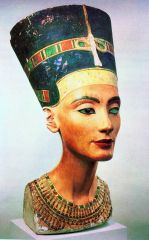
|
Queen Nefertiti
Amarna 1348-1336 BCE 18th dynasty limestone |
|

|
Tutankhamun
coffin cover 1325 BCE innermost part of coffin gold throughout only tomb not robbed 18th dynasty |
|
|
Who excavated the tomb of Tutankhamen?
|
Howard Carter
|
|
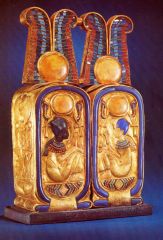
|
ovals called Cartouches
had name with it |
|
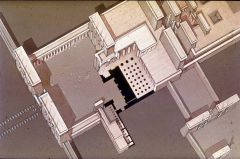
hypostale hall?
clerestory? |
Temple of Amun-Ra, Karnak
Hypostale hall-concentrated columns 66' high 22' in diameter clerestory-space lifted up(like windows) 19th dynasty new kingdom |
|
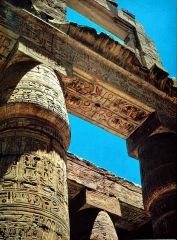
where?
|
Temple of Amun-Ra
Karnak hyroglyphic writings sunken reliefs were popular in the new kingdom |
|
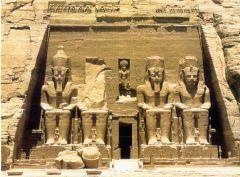
|
Temple of Ramses II, Abu Simbel, ca. 1279-1213 BCE
rock cut tomb 65' high children inbetween his feet 19th dynasty sandstone |
|
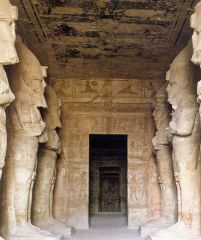
|
Temple of Ramses II
Abu Simbel 1279-1213 BCE 29th dynasty sandstone humanlike columns |
|
|
First named architect?
|
Imhotep
|
|
|
After an intermediate period of civil war, __________ re-established central rule and founded the middle kingdom
|
Mentuhotep
|
|
|
Chronology
|
the dating of art objects and buildings
|
|
|
refers to an objects shape and structure, 2D or 3D
|
form
|
|
|
refers to how the artist organizes forms in an artwork
|
composition
|
|
|
The process artists employ, such as applying paint to a canvas with a brush, and the distinctive, personal ways they handle materials constitute..
|
technique
|
|
|
the path of a point moving in space, an invisible line of sight
|
line
|
|
|
the bounded or boundless container of objects
3d or 2d |
space
|
|
|
descibe 3D objects in space
|
mass and volume
|
|
|
the representation of a figure or an object at an angle to the picture plane
|
foreshortening
|
|
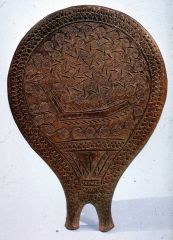
where?
human shaped? |
Frying pan”
site-Khalandriani Island-Syros Early Cycladic II ca. 2500 mycenian made of clay anthropomorphic-human shaped female genitalia |
|
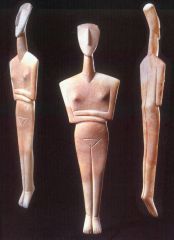
era?
where? |
Cycladic
figure ca. 2500 from syros cycladic art marble carved with emery- the largest supply of emery is found on these islands almost all women arms crossed pointed feet most found in tombs many fakes |
|
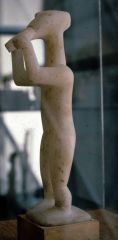
|
Keros flutist”
Keros ECII (2800-2300) |
|

|
Keros harpist”
from keros Amorgos ECIII (2300-2100) |
|
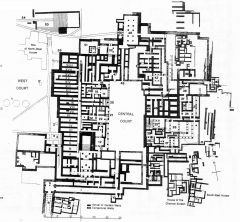
|
Palace complex, Knossos, ca. 1700-1300 BCE
Crete Minoan |
|
|
labyrith
|
hall of double axe
|
|
|
who is the daughter of Minos?
|
Ariadne
|
|
|
who excavated the site of Knosses?
|
Arthur evans
|
|
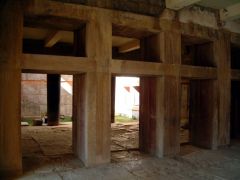
|
“Hall of the Double Axes” (King’s Megaron)
floor is gypsome rock minoan art |
|
|
In minoan mythology what Athenean king defeated the half bull Minotaur?
|
Theseus
|
|
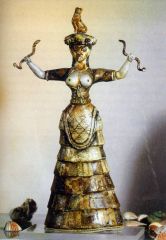
what era?
|
Snake goddess
Knossos MMIII ca. 1650 BCE found near temple Minoan 4"-6" high godess or preistess made of clay covered with glaze called-Faience snakes relate to the goddess of the underworld |
|

where is it from?
what is the hair madfe of? |
The Palaikastro
“kouros” from Palaikastro ca. 1450 fron Crete made of ivory kouros is a young man teeth of hippos had a gold loin cloth tiny waist is called a wasp waist hair made of serpentine |
|
|
Chryselephantine
|
gold and ivory sculpture
|
|
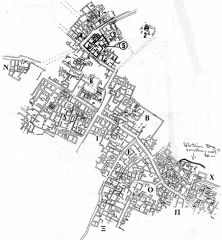
|
Palaikastro
LMIA-B ca. 1450 minoan famous for having sanctuary for zeus |
|
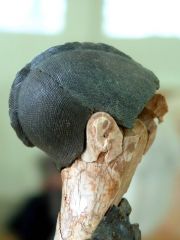
|
The Palaikastro
“kouros” Palaikastro ca. 1450 |
|
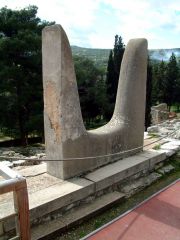
|
Horns of
consecration” Knossos ca. 1500 BCE |
|
|
|
Harvester Vase
ca. 1500 Haghia Triada made of stone shaped like egg ostrich egg 5" singing harvesters minoan shows underlying skeletal and muscular structure |
|
|
list the prehistoric Aegean in order
|
Early Clycladic art
Late minoan art Mycenean(late Helladic art) |
|
|
where is the greatest late Minoan palace?
|
Knosses
|
|
|
what was the largest form or art in the Minoan world?
|
Fresco painting
|
|
|
who later waged war on troy with the greeks?
|
Myceneans
|
|
|
who were the masters of corbel vaulting?
|
the Myceneans
|
|
|
The two Bison relief sculpture is
|
paleolithic
from Ariege france |
|
|
what is the earliest known settlement?
|
Jericho
|
|
|
Megolithic
|
big stone
|
|
|
who introduced cuneiform writing?
|
ancient near eastern
|
|
|
who put an end to the babylonian empire?
|
the hitites
|
|
|
Describe the step pyramid of Djoser
|
pre-dynastic
series of mastabas mile long 33' high 1rst names architect (Imhotep) |
|
|
the earliest known columns were found?
|
In the N palace of Djoser, Saqqara
egypt pre-dynastic |
|
|
The tombs of _______ are characteristic of the Middle kingdom
|
Beni Hasan
|
|
|
where is the bull leaping fresco located?
|
Knosses
|
|
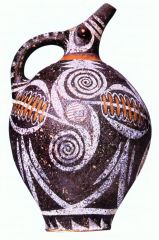
|
Kamares ware
jug Phaistos Ca. 1900 mycenean |
|
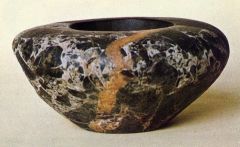
|
Stone bowl, Early Minoan (ca. 2200)
|
|
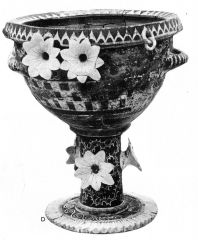
|
Kamares ware
goblet/chalice Phaistos Ca. 1900 plastic-decorations molded into a shape |
|
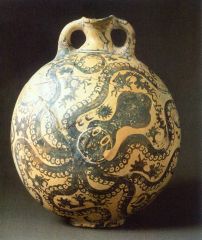
|
Octopus vase
Palaikastro ca. 1500 stirrup jar |
|

|
Thera (Santorini)
volcanoe one of the largest volcanic eruption destroyed town akrotiri erupted about 1628 BC |
|
|
counting of tree rings
|
Dendrochronology
|
|
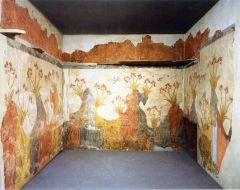
|
Spring Fresco, Thera, ca. 1600 BCE
Acrotiri |
|
|
large peninsula
|
Peloponneses
|
|
|
king of all greeks
|
Agamemnon
|
|
|
King of greeks lead against troy
|
Menelaws
|
|
|
who was the excavator or troy and mycenea?
|
Heirich Schiemann
|
|
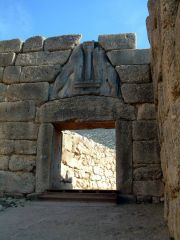
|
Lion Gate
Mycenae ca. 1250 corbel arch |
|
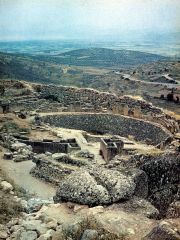
|
Grave
Mycenae 1600-1500 Circle A shaft down into bedrock filled with rich grave goods |
|
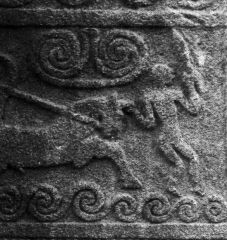
|
Chariot stele
Grave Circle A Mycenae MH Late 1600-1550 chariot stele |
|
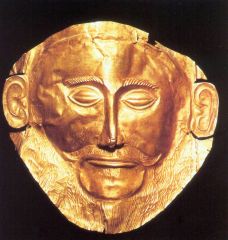
|
Mask of Agamemnon,” Grave 5
Grave Circle A, LHI (1550-1500) |

